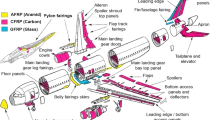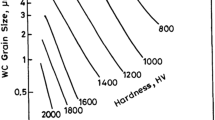Abstract
As a typical difficult-to-machine material, the strong wear resistance and high hardness of carbon fiber in carbon fiber–reinforced plastics (CFRPs) lead to rapid tool wear during the cutting process, exacerbating surface damage of the hole and significantly increasing production costs. The investigation of tool wear has always been the pivotal focus in low-cost manufacturing. However, no similar work has been reported yet in tool wear of CFRP helical milling To fill this gap, this paper aims to conduct a theoretical analysis of the tool wear mechanism in helical milling of CFRPs and summarize the trends in tool wear under different cutting amounts as well as the impact of tool wear on cutting force and hole quality. Tool wear characteristics in terms of helical milling were studied carefully. Discussions on the tool wear morphology, cutting parameters, cutting force, and hole wall roughness were also provided. The findings in this paper might offer guidance on tool wear mechanisms for extending tool life and increasing hole-making quality in helical milling of CFRPs.










Similar content being viewed by others
Data availability
All data generated or analyzed during this study are included in this article and its additional files.
Code availability
Not applicable.
References
Zhang J, Lin G, Vaidya U, Wang H (2023) Past, present and future prospective of global carbon fibre composite developments and applications. Composites Part B: Engineering 250. https://doi.org/10.1016/j.compositesb.2022.110463
Al-Furjan MSH, Shan L, Shen X, Zarei MS, Hajmohammad MH, Kolahchi R (2022) A review on fabrication techniques and tensile properties of glass, carbon, and Kevlar fiber reinforced rolymer composites. J Market Res 19:2930–2959. https://doi.org/10.1016/j.jmrt.2022.06.008
Geier N, Davim JP, Szalay T (2019) Advanced cutting tools and technologies for drilling carbon fibre reinforced polymer (CFRP) composites: a review. Composites Part A: Applied Science and Manufacturing 125. https://doi.org/10.1016/j.compositesa.2019.105552
Xu J, Kolesnyk V, Li C, Lysenko B, Peterka J, Gupta MK (2023) A critical review addressing conventional twist drilling mechanisms and quality of CFRP/Ti stacks. J Market Res 24:6614–6651. https://doi.org/10.1016/j.jmrt.2023.04.226
Cao S, Li HN, Tan G, Wu C, Huang W, Zhou Q, Hu Z (2023) Bi-directional drilling of CFRPs: from principle to delamination suppression. Composites Part B: Engineering 248. https://doi.org/10.1016/j.compositesb.2022.110385
Cao S, Li HN, Huang W, Zhou Q, Lei T, Wu C (2022) A delamination prediction model in ultrasonic vibration assisted drilling of CFRP composites. Journal of Materials Processing Technology 302. https://doi.org/10.1016/j.jmatprotec.2021.117480
Xu J, Yin Y, Paulo Davim J, Li L, Ji M, Geier N, Chen M (2022) A critical review addressing drilling-induced damage of CFRP composites. Composite Structures 294. https://doi.org/10.1016/j.compstruct.2022.115594
Poór DI, Geier N, Pereszlai C, Xu J (2021) A critical review of the drilling of CFRP composites: burr formation, characterisation and challenges. Composites Part B: Engineering 223. https://doi.org/10.1016/j.compositesb.2021.109155
Xu J, Geier N, Shen J, Krishnaraj V, Samsudeensadham S (2023) A review on CFRP drilling: fundamental mechanisms, damage issues, and approaches toward high-quality drilling. J Market Res 24:9677–9707. https://doi.org/10.1016/j.jmrt.2023.05.023
Pereira RBD, Brandão LC, de Paiva AP, Ferreira JR, Davim JP (2017) A review of helical milling process. Int J Mach Tools Manuf 120:27–48. https://doi.org/10.1016/j.ijmachtools.2017.05.002
Kalla D, Sheikh-Ahmad J, Twomey J (2010) Prediction of cutting forces in helical end milling fiber reinforced polymers. Int J Mach Tools Manuf 50(10):882–891. https://doi.org/10.1016/j.ijmachtools.2010.06.005
Liu J, Chen G, Ji C, Qin X, Li H, Ren C (2014) An investigation of workpiece temperature variation of helical milling for carbon fiber reinforced plastics (CFRP). Int J Mach Tools Manuf 86:89–103. https://doi.org/10.1016/j.ijmachtools.2014.06.008
Liu J, Chen G, Ren C, Qin X, Zou Y, Ge J (2020) Effects of axial and longitudinal-torsional vibration on fiber removal in ultrasonic vibration helical milling of CFRP composites. J Manuf Process 58:868–883. https://doi.org/10.1016/j.jmapro.2020.08.071
Wang X, Kwona PY, Sturtevant C, Kim D, Lantrip J (2013) Tool wear of coated drills in drilling CFRP. J Manuf Process 15(1):127–135. https://doi.org/10.1016/j.jmapro.2012.09.019
Xu JY, Lin TY, Davim JP, Chen M, El Mansori M (2021) Wear behavior of special tools in the drilling of CFRP composite laminates. Wear 476. https://doi.org/10.1016/j.wear.2021.203738
Fernández-Pérez J, Díaz-Álvarez J, Miguélez MH, Cantero JL (2021) Combined analysis of wear mechanisms and delamination in CFRP drilling. Composite Structures 255. https://doi.org/10.1016/j.compstruct.2020.112774
Li S, Qin X, Jin Y, Sun D, Li Y (2017) A comparative study of hole-making performance by coated and uncoated WC/Co cutters in helical milling of Ti/CFRP stacks. Int J Adv Manuf Technol 94(5–8):2645–2658. https://doi.org/10.1007/s00170-017-0842-8
Liang X, Wu D (2019) Tribological properties of carbon-fibre-reinforced plastic against tungsten carbide under dry condition. Tribol Int 134:118–128. https://doi.org/10.1016/j.triboint.2019.01.043
Xu JY, Zhou L, Chen M, Ren F (2019) Experimental study on mechanical drilling of carbon/epoxy composite-Ti6Al4V stacks. Mater Manuf Processes 34(7):715–725. https://doi.org/10.1080/10426914.2019.1594275
Jia ZY, Bai Y, Wang FJ, Hao JX (2020) Effect of tool wear on drilling unidirectional CFRP laminates in different fiber cutting angles. Int J Adv Manuf Technol 110(1–2):89–99. https://doi.org/10.1007/s00170-020-05872-z
Chen T, Lu YJ, Wang YS, Liu G, Liu GJ (2021) Comparative study on cutting performance of conventional and ultrasonic-assisted bi-directional helical milling of CFRP. Int J Adv Manuf Technol 115(11–12):3701–3711. https://doi.org/10.1007/s00170-021-07418-3
Denkena B, Boehnke D, Dege JH (2008) Helical milling of CFRP–titanium layer compounds. CIRP J Manuf Sci Technol 1(2):64–69. https://doi.org/10.1016/j.cirpj.2008.09.009
Fernández-Vidal SR, Mayuet P, Rivero A, Salguero J, del Sol I, Marcos M (2015) Analysis of the effects of tool wear on dry helical milling of Ti6Al4V alloy. Procedia Eng 132:593–599. https://doi.org/10.1016/j.proeng.2015.12.536
Childs T, Maekawa K, Obikawa T, Yamane Y (2000) Metal machining: theory and applications.
Zou L, Li H, Yang YG, Huang Y (2020) Feasibility study of minimum quantity lubrication assisted belt grinding of titanium alloys. Mater Manuf Processes 35(9):961–968. https://doi.org/10.1080/10426914.2020.1747625
Robinson GM, Jackson MJ, Whitfield MD (2007) A review of machining theory and tool wear with a view to developing micro and nano machining processes. J Mater Sci 42(6):2002–2015. https://doi.org/10.1007/s10853-006-0171-z
Kaynak Y, Karaca HE, Noebe RD, Jawahir IS (2013) Analysis of tool-wear and cutting force components in dry, preheated, and cryogenic machining of NiTi shape memory alloys. Procedia CIRP 8:498–503. https://doi.org/10.1016/j.procir.2013.06.140
Tu L, Deng Y, Zheng T, Han L, An Q, Ming W, Chen M (2022) Wear and friction analysis of cubic boron nitride tools with different binders in high-speed turning of nickel-based superalloys. Tribol Int 173. https://doi.org/10.1016/j.triboint.2022.107659
Funding
The work described in this paper is supported by the National Natural Science Foundation of China (52275506, 52305500).
Author information
Authors and Affiliations
Contributions
Shiyu Cao: writing and preparation of original draft, and methodology. Xuyan Zhang: investigation, formal analysis, and resources. Chaoqun Wu: reviewing and editing, funding acquisition, conceptualization, and supervision. Yufei Tang: investigation, reviewing, and editing. Minghui Yang: investigation and validation. Wenjian Huang: investigation and data curation. Dahu Zhu: reviewing and editing. Wenjie Zhan: investigation.
Corresponding author
Ethics declarations
Conflict of interest
The authors declare no competing interests.
Additional information
Publisher's Note
Springer Nature remains neutral with regard to jurisdictional claims in published maps and institutional affiliations.
Rights and permissions
Springer Nature or its licensor (e.g. a society or other partner) holds exclusive rights to this article under a publishing agreement with the author(s) or other rightsholder(s); author self-archiving of the accepted manuscript version of this article is solely governed by the terms of such publishing agreement and applicable law.
About this article
Cite this article
Cao, S., Zhang, X., Wu, C. et al. Experimental investigation on tool wear and hole quality in helical milling of CFRPs. Int J Adv Manuf Technol 130, 4791–4803 (2024). https://doi.org/10.1007/s00170-024-13003-1
Received:
Accepted:
Published:
Issue Date:
DOI: https://doi.org/10.1007/s00170-024-13003-1




